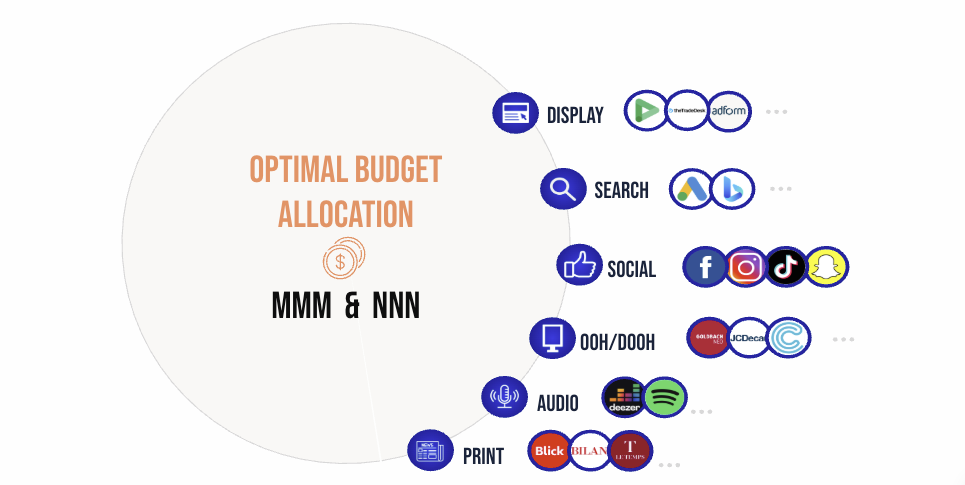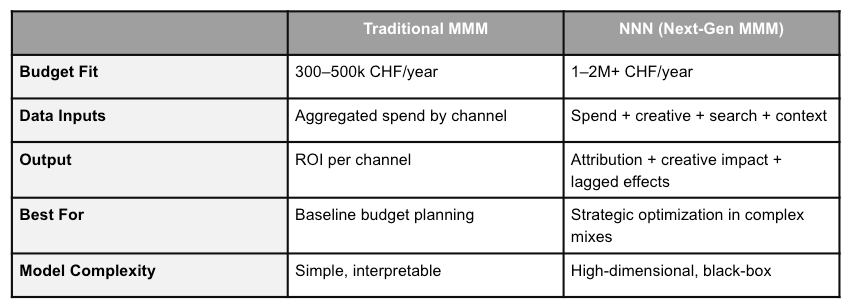Smarter Budget Decisions with Google’s NNN: What Marketing Leaders Should Know

Google just introduced something new in the world of media measurement — and it’s built for marketers asking tougher questions about what really drives results.
Marketing budgets aren’t growing like they used to. And as pressure to prove ROI intensifies, it’s no longer enough to know how much was spent or where. What matters now is:
👉 Which channel actually contributed?
👉 Which creative really worked?
👉 And how do these pieces work together over time?
Marketing Mix Modeling (MMM) has long been one of the most reliable ways to answer that. It helps marketers understand how different media channels contribute to business outcomes — without relying on user-level tracking. Now, with the release of NNN (Next-Gen Neural Network), Google is introducing a new way to approach MMM that could reshape how brands think about attribution and budget allocation.

The Problem with Traditional MMM
Traditional MMM models — whether linear or Bayesian — have their strengths. They’re interpretable, work well with historical data, and offer directional guidance on what’s driving ROI. But they also have serious limitations.
Most notably, they assume fairly static relationships between input (e.g. media spend) and output (e.g. sales). They can miss the longer-term effects of brand campaigns or the indirect role that one channel plays in boosting the performance of another — like a TV campaign driving more branded searches, which in turn increase conversion in paid search.
Traditional models also tend to treat all impressions within a channel the same. Whether you’re running a high-impact video ad or a forgettable display banner, the model might just see “X thousand impressions” and treat them equally.
Enter NNN: A Richer Approach
NNN is Google’s proposed solution to these gaps. It brings in transformer-based neural networks, similar to those used in modern AI models, and applies them to the MMM use case. The idea is to move beyond basic statistical relationships and instead train a model that can learn the complex, nonlinear ways media works across time and channels. Besides, by including the basic component of recent Large Language Models, it is able to encode and analyze even non numerical data.
Rather than relying solely on aggregated inputs like “TV spend per week,” NNN can incorporate richer signals: characteristics of the creative, changes in organic search trends, and even interactions between different channels. This means the model doesn’t just look at how much you spent — it also starts to understand what you said, where you said it, and how people responded.
Another key feature is NNN’s ability to capture delayed and indirect effects. Where traditional models may give most credit to channels that appear directly before a sale, NNN can trace back how earlier brand activity may have influenced eventual outcomes — a crucial capability for full-funnel marketers.
When Does NNN Make Sense?
This kind of modeling isn’t for every business. Based on what’s been published, NNN is best suited for large-scale advertisers with:
● Substantial media budgets (typically CHF 1M+ annually)
● A complex mix of channels (e.g. TV, video, search, social)
● Diverse creative assets and messaging
● Reliable access to historical performance and search data
If your campaigns are mostly short-term, performance-driven, and your media mix is simple, traditional MMM is likely still the right fit. But if you’re running integrated campaigns across geos and formats, where brand and performance work together — NNN can help unpack the real drivers of return.
Traditional MMM vs. NNN — At a Glance

What It Means for Budget Planning
For marketing managers, the main question is simple: how will this help me plan better?
The promise of NNN is that it delivers more accurate, more realistic insights — especially in situations where channels influence each other or where media has long-tail effects. That means better guidance on where to shift budget, which creatives are actually working, and which channels deserve long-term investment even if they don’t convert right away.
Rather than asking “what gave us the last click,” NNN helps answer “what actually moved people toward purchase over time.” And in a world where marketing attribution is increasingly fragmented, that’s a powerful perspective.
The Catch? It’s Not Plug-and-Play
NNN, like most neural models, is complex. It’s not available in off-the-shelf analytics tools, and implementation would require data science resources, thoughtful data preparation, and a fair amount of infrastructure. One can expect Google will provide a similar infrastructure as Meridian once the model is open for the public.
This isn’t necessarily a downside — just a reminder that the value of NNN lies in its customizability and depth, not in being a turnkey dashboard. For larger brands with the right setup, the investment may be well worth the insights.
Final Thoughts
NNN represents an important step forward in how we measure marketing effectiveness. It doesn’t replace traditional MMM — it expands what’s possible for marketers who need a more detailed view of what’s working and why.
As media strategies grow more complex and privacy regulations evolve, tools like NNN will likely play a bigger role in guiding decisions. For now, it’s an opportunity to start rethinking how we define performance — and to plan smarter with the data we already have.
Ready to determine the right modeling strategy for your brand? Contact our team of experts today for a personalized consultation.
Download our trendbook

Our TrendBook, born from the fusion of our agency’s expertise, unveils four key trends shaping the media and advertising industry, carefully analyzed by our experts:
- How to capture consumers in the age of the Messy Funnel
- Why AI is emerging as a cultural revolution
- How television is evolving into a multifaceted medium
- Why influencer marketing has reached the age of maturity



.png)
